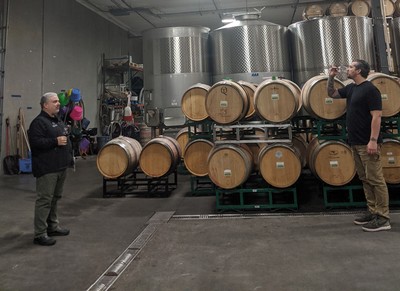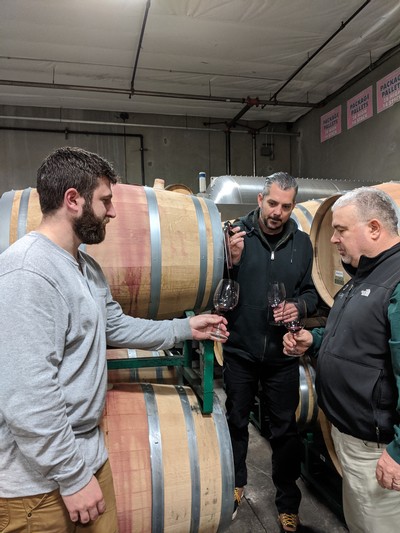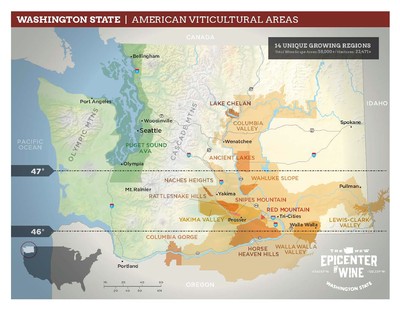Importance of the Blend
While we begin to pour the 2017 vintage, Charlie is gearing up for the upcoming 2020 harvest, letting the 2019’s receives some much-needed beauty sleep, and considering blends for the 2018 vintage. I sat down with Charlie earlier this week and picked his mind about the importance of blending, the newest releases, and the process.
"A blend is the truest form of the best wine you can make." Charlie always looks for what he likes. “I don’t necessarily make blends for an end consumer; I make blends that appeal to my palate and hope others like it- apparently, they do. In Bordeaux, it’s always a blend and you’re not asking what it's a blend of. But if there’s any artistry in winemaking, it’s blending. Another winemaker could take the exact same fruit and create a completly different wine."

The 2017 ‘Blends’
The only wine made in 2000, and every year since- the Optu Red Mountain. This is the 17thvintage, and the 18threlease of this wine. What started out as the Meritage, eventually became Optu. "There is no recipe, but it’s always Cabernet Sauvignon dominant, with a few vintage exceptions." Charlie shoots for 75% Cabernet. He adds "Merlot for depth and length, Petit Verdot for concentration and structure, and Cabernet Franc for finesse and softening."
Charlie tries to differentiate our Cabernets by not only vineyards, but clones. The 2017 Red Mountain Cabernet is a blend of vineyards (62% Quintessence Vineyard + 38% Estate Vineyard) but a singular clone. With his favorite varietal, Merlot, he experiments with different vineyard sites, including Blackwood Canyon’s newer plantings to the north of the tasting room. He also blends fruit from Red Mountain Vineyard, Kiona's Estate, and Quintessence for this wine.

The Blending Process
Blending begins over Christmas break, when the cellar is empty. Every single barrel is then laid out across the entire cellar floor, two barrels high. Then Charlie, Mitch, and Will taste everything, and Charlie starts piecing the blends together in his head. Charlie admits that although they can have different perspectives and opinions on some of the wines, someone has to make the final call and that's him.
Over about three days, Charlie and the team spends hours tasting through everything. In about 2 hours, they’ll taste through 20-30 wines before their palates become fatigued. Because the cellar crew isn’t around, they aren’t shy about spitting in the drain that runs the length of the cellar floor.

Everything is separated not only by varietal and vineyard site, but by fermentation vessel used, and oak treatment. There are a lot of variables, but everything is accounted for. With this, Charlie and the team can tinker with what juice they prefer in each. For example, the team has learned that Clone 169 Cabernet in a roller barrel leads to over extraction. This is because the ‘cap’ of the wine is constantly submerged. The fermentation kinetics lead to the wine being overly tannic. Even when a wine that is being poured in the tasting room is labeled as a single varietal, single vineyard, there is still a ‘blend’ of fermentation styles and oaks that needs to be determined. He works at refining the fermentation and barrel program while also determining the blends that will come to life.
Charlie is constantly improving the production of Fidelitas wines. This continuous improvement, always leads us and Charlie to the affirmation that our best vintage is yet to come.
The Optimal Blend: Charlie Hoppes + Red Mountain
There are many beautiful wines being made here in Washington state – the compilation of so many talented wine makers using fruit from various Washington AVA’s. But in my opinion, the combination of Charlie Hoppes, our winemaker, and Red Mountain is a union that simply can’t be beat. Here’s why.
Charlie has been making wine in Washington state for over 33 years but his passion for Red Mountain all started in 1989, the very same day his first daughter was born. He was pouring wines at Kiona’s Lemberger days for Langguth Winery. There he tasted his first Red Mountain Cabernet from Kiona – the structure, that intense fruit and distinctive minerality! It was extraordinary and that started his love affair with Red Mountain. In those early days there simply was not enough fruit grown on Red Mountain to start a winery sourced solely on that fruit. But that didn’t stop Charlie from ultimately pursuing that dream. It took him a few years, but Fidelitas now sources ALL it’s fruit from Red Mountain vineyard partners, and most notably, our Estate vineyard that yields more and more fruit for our lineup of wines.
Today, Charlie takes his years of experience in the cellar and combines that with relationships he has built over these 33 years with people like Marshall Edwards (Quintessence Vineyard Manager), Dick Boushey (of Boushey Vineyards in Yakima and our Estate manager) and the Holmes family at iconic Ciel du Cheval Vineyard. All those relationships are key to sourcing the BEST fruit on Red Mountain, which Charlie usually designates block by block and sometimes row by row. Being a talented wine maker simply isn’t enough to make impeccable wine – it takes extraordinary fruit and knowing exactly where that is on Red Mountain and having the handshake relationships to source it.
So that leads us to Red Mountain and what makes it a World Class AVA. Red Mountain is located NOT in Walla Walla, but about 15 miles west of Richland, WA. Spread the word, Red Mountain is ON THE WAY TO Walla Walla, not IN Walla Walla and deserves a detour off I-82!

Want to visit tasting rooms actually in the vineyards? Google Maps to Fidelitas Red Mountain. You can thank me later. Red Mountain is getting worldwide attention for good reason. It produces killer fruit showing wines with great depth, structure and ageability. Here’s why:
- The Missoula Floods Created Red Mountain – these are cataclysmic floods that occurred at the end of the Ice Age. The repeated 400-foot torrents down the Clark Fork and Columbia River collected in eddies and valleys and dropped sediment. Depositing everything from large boulders to microscopic silt and everything in between. The deposits are deep, meaning low nutrients and well-drained soil. For vineyards, THIS IS THE PERFECT TERROIR. The vines grow very deep roots to collect nutrients and water. And a vine that struggles to survive, gives EVERYTHING to the fruit not the leaf structure or canopy.
- Hot, Hot Hot! Eastern Washington is high desert and gets over 300 days of sun. But Red Mountain’s heat accumulation is the highest in the state. Meaning consistently, fully ripe fruit year to year. Only 6”-8” of rainfall annually means the grower can control “starving” the vine with fine-tuned irrigation and that means the ability to achieve CONSISTENT quality from vintage to vintage.
- Consistent Winds and Southwest Facing Slope – the prevailing winds come out of the SW and are notorious for their frequency and velocity. Red Mountain is at the end of the wind tunnel of the Yakima Valley that causes the wind to constantly blow and in very strong gusts. That creates an environment where the grape clusters stay quite small and have thicker skins to protect the seeds within. A savvy winemaker knows that will mean concentrated flavors of the fruit, richness and intensity. (Ok, now I’m dying for a glass. If you haven’t pulled the cork on that bottle of Fidelitas yet, then you must be a beer drinker.)
- The Best of Old World Meets New World – it’s true. Red Mountain fruit exemplifies the New World ripeness of flavor from wine regions like California and Australia yet combines that with an Old-World acid and tannin structure like France and Italy. Who says you can’t have it all?

And that my friends is why Red Mountain is at the heart of Fidelitas. It just doesn’t get any better than this. So, stop in at either of our tasting rooms in Woodinville or on Red Mountain, and we’ll happily pour you some of the best wine in WA. Not in our wine club family yet? That’s a shame because many of the wines being released this year are from one of the very best vintages for Fidelitas and only available to our club members. Come join us!
Top Reasons We Love Custom Clubs
Yesterday, I was interviewed on what we call custom clubs or user choice clubs. Basically, the style of the Fidelitas Wine Club, where we are encouraging our members to select the wines that will go into their allocations. Once I got off the call, I sat back and thought about why this is such a unique model and how it truly does benefit our members.
Touting the benefits of custom clubs is nothing new on this blog. We wrote about it just last November and again back in 2018 when we brought our third Club with the most members over to this Club style. My apologies if it is getting redundant. We are JUST THAT EXCITED about giving our members the option to select their own allocations. Top reasons we love selling wine via Custom Club:
Our members get what they want.
We used to have members we would hand-customize their shipments because they didn’t want the Merlot (which is crazy because Charlie’s Merlots are out of this world) or even Cabernet (which might be even crazier). We’ll always release a variety of wines that are available to customize with so members can still get a variety, but only with the wines they really like.
The selections go beyond just varietals, though. I recently realized that this gives people the power to buy wines how they want to drink them. If you like to drink your wines sooner than later, and love a sampling of different things, grab one bottle of each new release. If you have an awesome cellar, go all in on your favorite one for your allocation and then round up to a case with a few more plus some daily drinkers for variety. Charlie and I both love to check in with one wine year after year just to see how it’s maturing in the bottle.
We also realize that what a lot of people want is to not make any choices at all, and we can totally do that. You know you like the wines, and we are more than happy to build an allocation for you.
We can design wines with the Club in mind.
This is one of my favorite things about Fidelitas. Many wineries may be scared of selling via Custom Club because it doesn’t fit with the wines that they are already making. However, we are making wines that we know our members are going to love, no matter the amount of cases produced, and allow these small lots to be sold via Club allocations because it is first come, first served. Once those 48 cases of Clone 191 are gone, they are gone but the members who really wanted them made sure to get them!
I’ve talked about this many times over the years. Charlie, like pretty much any winemaker I’ve ever met, is a sort of mad scientist. And he looooves making wines. Like, wants to make little tiny lots of everything and has an amazing knack for knowing what people are going to want in three years. This is how we end up with 48, 96, 142, 244 case lots. Allowing members to put these tiny production wines in their Club allocations guarantees that Charlie gets to make those amazing wines and members don’t necessarily have to buy above and beyond their allocation to enjoy them (although, as stated above, you should get more because once they are gone, they’re gone).
Further, “Club-exclusive” is a common thing to see at wineries. However, I realized that it is so much more than that at Fidelitas. One of part of my job is to work with Charlie and design how our releases will look up to 3 years in advance. Already, we are talking about which wines we want to make from grapes that will be harvested this upcoming fall. That means, we are having discussions about how much fruit to buy 5 months from now to make a wine that won’t be released until 3 years from now. We are looking at spreadsheets, and forecasts, and weather patterns, just to determine what wines we’ll make for just our Club members. This isn’t an after the fact decision. The wines available in your Club selections are truly chosen by Charlie 3+ years before you will take it home. Over the course of those 3 years, Charlie is ensuring that wine in your allocation is “one of the best we’ve ever made” (one of our favorite Charlie-isms).
Custom Clubs allow us to interact with our members in all new ways.
This is kind of a unique topic that I’ve been exploring. However, in 2019 we sold 75% of all wine to members and roughly 14 products never made it beyond the Club to even the tasting rooms. So – if a wine isn’t being poured in the tasting room, how do we know if people will like it?
Running Custom clubs for a few years now means that our team has really gotten to know our Club: their likes and dislikes, and how much they are wanting to take in each offering. Skye spends hours a day on the phone chatting with members to hear how past vintages are tasting now and helping them to select the wines that they’ll be taking home. In the tasting rooms, Team Fidelitas is sitting down with members to chat through each release to ensure that members are securing the want, and then diligently getting those orders fulfilled and sent home weeks later. It’s a little different than the traditional tasting room model, but gives our members a much more personal experience.
I can’t wait to release these new wines and will be spending next week on Red Mountain making sure that the exact right selections are making their way to their forever home. Enjoy them once they arrive!
